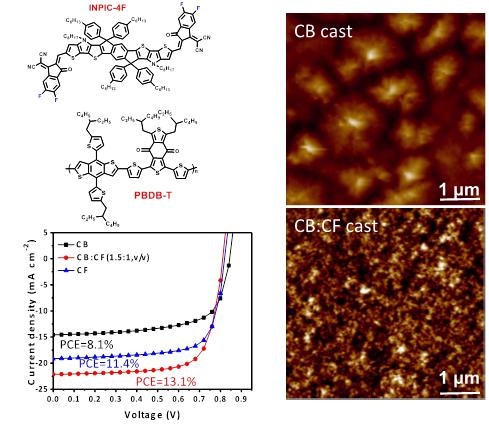Jun 13 2019
In the last few years, the use of non-fullerene electron acceptors (NFAs) has represented a remarkable advancement of organic solar cells (OSCs).
 The chemical structures of electron donor PBDB-T and fluorinated NFA INPIC-4F; the J-V characteristics of PBDB-T:INPIC-4F solar cells cast from different solvents; the AFM images of PBDB-T:INPIC-4F surfaces cast from CB and CB:CF. (Image credit: Science China Press)
The chemical structures of electron donor PBDB-T and fluorinated NFA INPIC-4F; the J-V characteristics of PBDB-T:INPIC-4F solar cells cast from different solvents; the AFM images of PBDB-T:INPIC-4F surfaces cast from CB and CB:CF. (Image credit: Science China Press)
When compared to fullerene derivative acceptors, NFAs present a lot of benefits, including broad absorption spectrum, tunable energy levels, and high carrier mobility, as well as strong light absorption ability. In order to enhance the efficiency of non-fullerene OSCs further, chlorine (Cl) or fluorine (F) atoms have been incorporated into the chemical structure of NFAs as an effective strategy to modulate the LUMO and HOMO levels.
Large electronegativity and a small Van der Waals radius allow the F atom to enhance the molecular planarity and aggregation tendency of NFAs, and also to increase their crystallization ability.
However, the affinity of fluorinated NFAs to self-organize into crystals often results in excessive phase separation, which has been found to improve the film surface roughness to maximize charge recombination at the electrode interface, and above all to decrease the bulk heterojunction interfaces within the photoactive layer—impacts that all result in decreased power efficiency.
Most recently, Professor Tao Wang’s team from Wuhan University of Technology presented an effective method to modify the molecular organization of a fluorinated NFA (INPIC-4F), and its phase separation with the donor PBDB-T, by changing the casting solvent (CB, CF, and their mixtures).
Upon using a high boiling-point solvent CB as the casting solvent, INPIC-4F developed lamellar crystals, which further develop into micron-scale spherulites, producing a low PCE of just 8.1%. Upon using the low boiling-point solvent CF, the crystallization of INPIC-4F has been restrained and the low structure order results in a moderate PCE of 11.4%.
The use of binary solvent mixture (CB:CF = 1.5:1, v/v) enhanced the efficiency of PBDB-T:INPIC-4F non-fullerene OSCs to 13.1%. These outcomes demonstrate the excellent potential of binary solvent approach to control the molecular order and nanoscale morphology for high-efficiency non-fullerene solar cells.
This research was supported by the Natural Science Foundation of Hubei Province (Grant No. 2018CFA055) and the National Natural Science Foundation of China (Grants No. 21774097, 21504065, 51573077, and 21875111).